Memory Stick on:
[Wikipedia]
[Google]
[Amazon]
The Memory Stick is a removable flash
 Typically, Memory Sticks are used as storage media for a portable device, in a form that can easily be removed for access by a personal computer. For example, Sony digital compact cameras use Memory Stick for storing image files. With a Memory Stick-capable memory card reader a user can copy the pictures taken with the Sony digital camera to a computer. Sony typically included Memory Stick reader hardware in its first-party consumer electronics, such as digital cameras, digital music players, PDAs,
Typically, Memory Sticks are used as storage media for a portable device, in a form that can easily be removed for access by a personal computer. For example, Sony digital compact cameras use Memory Stick for storing image files. With a Memory Stick-capable memory card reader a user can copy the pictures taken with the Sony digital camera to a computer. Sony typically included Memory Stick reader hardware in its first-party consumer electronics, such as digital cameras, digital music players, PDAs,
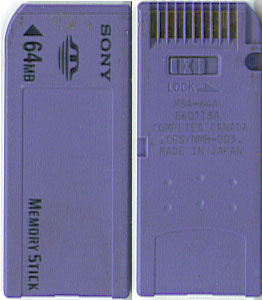
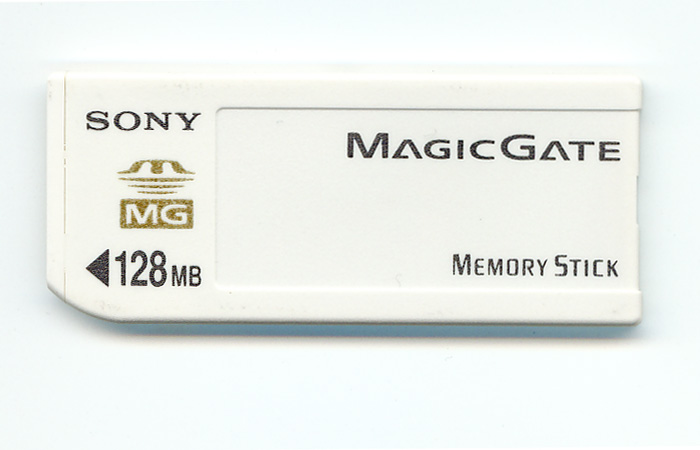 Introduced in July 1998. The original Memory Stick is approximately the size and thickness of a stick of chewing gum. It was available in capacities from 4 MB to 128 MB (1 MB = one million bytes). It was available both with and without
Introduced in July 1998. The original Memory Stick is approximately the size and thickness of a stick of chewing gum. It was available in capacities from 4 MB to 128 MB (1 MB = one million bytes). It was available both with and without
 In response to the storage limitations of the original Memory Stick, Sony introduced the Memory Stick Select at CES 2003 on January 9. The Memory Stick Select contained two separate 128 MB partitions which the user could switch between using a physical switch on the card. This solution was fairly unpopular, but it did give users of older Memory Stick devices more capacity. Its physical size remained the same as the original Memory Stick.
In response to the storage limitations of the original Memory Stick, Sony introduced the Memory Stick Select at CES 2003 on January 9. The Memory Stick Select contained two separate 128 MB partitions which the user could switch between using a physical switch on the card. This solution was fairly unpopular, but it did give users of older Memory Stick devices more capacity. Its physical size remained the same as the original Memory Stick.
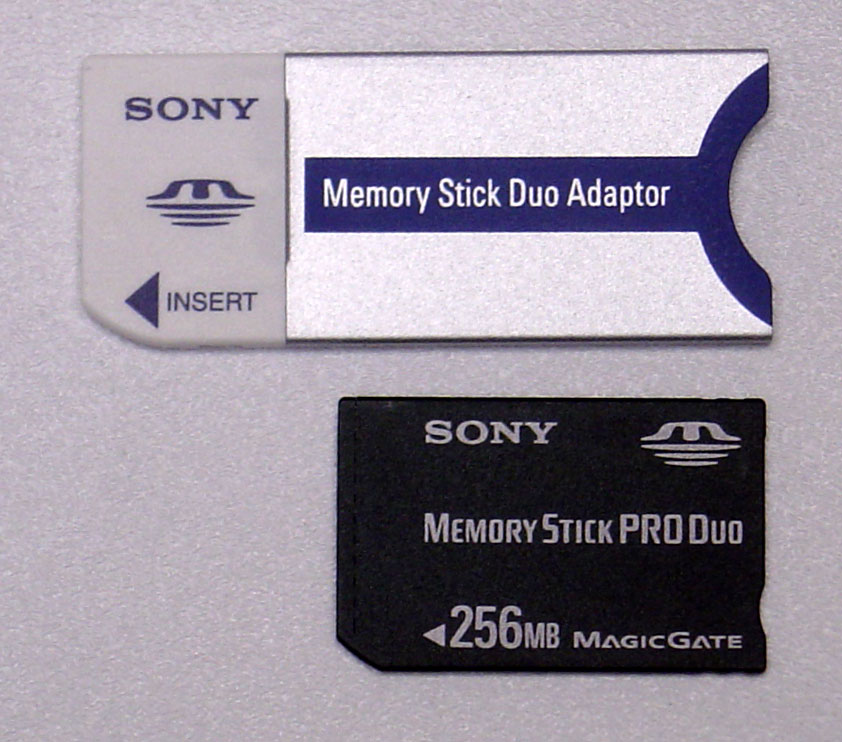 A simple adapter allows Memory Stick Duo to be used in devices designed to accept the original Memory Stick form factor.
A simple adapter allows Memory Stick Duo to be used in devices designed to accept the original Memory Stick form factor.
 The Memory Stick PRO Duo (MSPD) quickly replaced the Memory Stick Duo due to the Duo's size limitation of 128 MB and slow transfer speed. Memory Stick PRO Duos are available in all the same variants as the larger Memory Stick PRO, with and without High Speed mode, and with and without MagicGate support.
Sony has released different versions of Memory Stick PRO Duo. A Memory Stick PRO Duo with MagicGate was released as a 512 MB stick. Additionally, a 16 GB version in March 2008 and another a 32 GB version on August 21, 2009. In 2009, Sony and SanDisk also announced the joint development of an expanded Memory Stick PRO format tentatively named "Memory Stick PRO Format for Extended High Capacity". Sony has since finalized the format and released its specification under the new name, ''Memory Stick XC'' (see below).
There exist adapters for those who want to use microSD cards, on devices that only support Memory Stick PRO Duo cards, that allows those to use the storage on a microSD for files on the device in question.
The Memory Stick PRO Duo (MSPD) quickly replaced the Memory Stick Duo due to the Duo's size limitation of 128 MB and slow transfer speed. Memory Stick PRO Duos are available in all the same variants as the larger Memory Stick PRO, with and without High Speed mode, and with and without MagicGate support.
Sony has released different versions of Memory Stick PRO Duo. A Memory Stick PRO Duo with MagicGate was released as a 512 MB stick. Additionally, a 16 GB version in March 2008 and another a 32 GB version on August 21, 2009. In 2009, Sony and SanDisk also announced the joint development of an expanded Memory Stick PRO format tentatively named "Memory Stick PRO Format for Extended High Capacity". Sony has since finalized the format and released its specification under the new name, ''Memory Stick XC'' (see below).
There exist adapters for those who want to use microSD cards, on devices that only support Memory Stick PRO Duo cards, that allows those to use the storage on a microSD for files on the device in question.
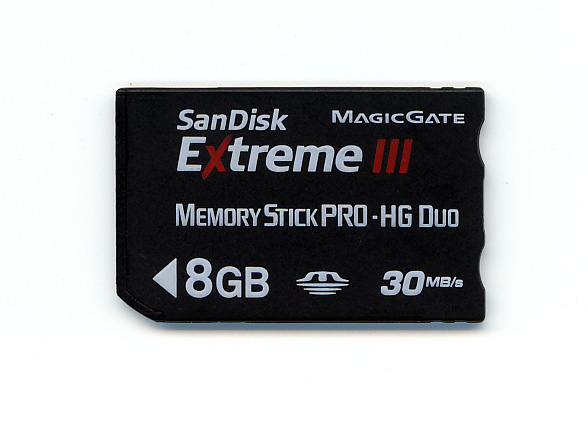 On December 11, 2006, Sony, together with SanDisk, announced the Memory Stick PRO-HG Duo. While only serial and 4-bit parallel interfaces are supported in the Memory Stick PRO format, an 8-bit parallel interface was added to the Memory Stick PRO-HG format. Also, the maximum interface clock frequency was increased from 40 MHz to 60 MHz. With these enhancements, a theoretical transfer rate of 480 Mbit/s (60 MB/s) is achieved, which is three times faster than the Memory Stick PRO format.
On December 11, 2006, Sony, together with SanDisk, announced the Memory Stick PRO-HG Duo. While only serial and 4-bit parallel interfaces are supported in the Memory Stick PRO format, an 8-bit parallel interface was added to the Memory Stick PRO-HG format. Also, the maximum interface clock frequency was increased from 40 MHz to 60 MHz. With these enhancements, a theoretical transfer rate of 480 Mbit/s (60 MB/s) is achieved, which is three times faster than the Memory Stick PRO format.
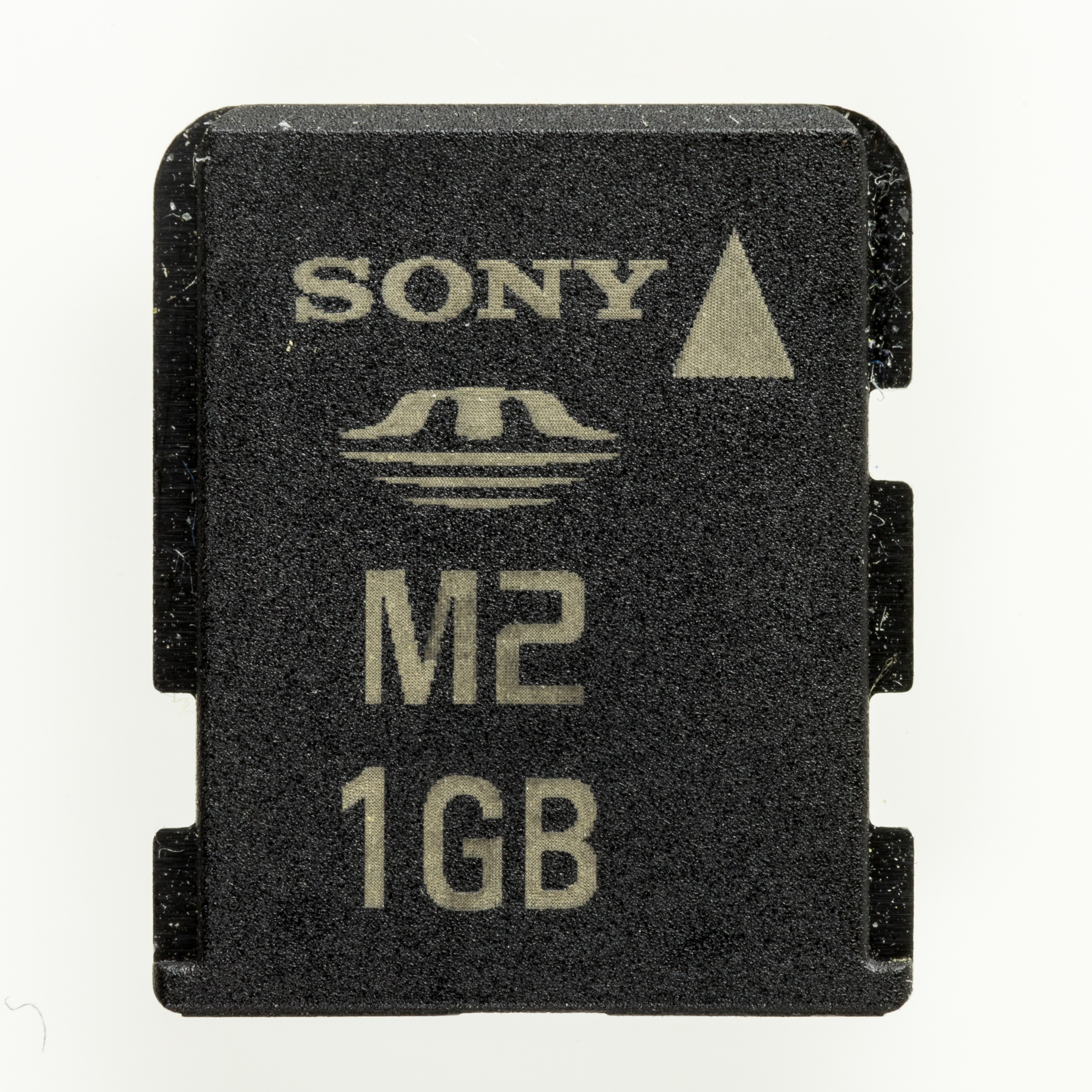 In a joint venture with SanDisk, Sony released a new Memory Stick format on February 6, 2006. The Memory Stick Micro (M2) measures 15 × 12.5 × 1.2 mm (roughly one-quarter the size of the Duo) with 64 MB, 128 MB, 256 MB, 512 MB, 1 GB, 2 GB, 4 GB, 8 GB, and 16 GB capacities available. The format has a theoretical limit of 32 GB and maximum transfer speed of 160 Mbit/s. However, as with the ''PRO Duo'' format, it has been expanded through the ''XC'' series as ''Memory Stick XC Micro'' and ''Memory Stick XC-HG Micro'', both with the ''theoretical'' maximum capacity of 2 TB.
The M2 comes with an adapter, much like the Duo Sticks, to ensure physical compatibility with Memory Stick PRO devices. However, not all devices with a PRO slot are compatible with the M2/Adapter combination, as the firmware of older devices don't support the higher capacity of some M2 cards. One example is certain Sony CLIÉ PDAs which don't support cards larger than 2 GB.
Sony announced on June 1, 2009, that M2 support in
In a joint venture with SanDisk, Sony released a new Memory Stick format on February 6, 2006. The Memory Stick Micro (M2) measures 15 × 12.5 × 1.2 mm (roughly one-quarter the size of the Duo) with 64 MB, 128 MB, 256 MB, 512 MB, 1 GB, 2 GB, 4 GB, 8 GB, and 16 GB capacities available. The format has a theoretical limit of 32 GB and maximum transfer speed of 160 Mbit/s. However, as with the ''PRO Duo'' format, it has been expanded through the ''XC'' series as ''Memory Stick XC Micro'' and ''Memory Stick XC-HG Micro'', both with the ''theoretical'' maximum capacity of 2 TB.
The M2 comes with an adapter, much like the Duo Sticks, to ensure physical compatibility with Memory Stick PRO devices. However, not all devices with a PRO slot are compatible with the M2/Adapter combination, as the firmware of older devices don't support the higher capacity of some M2 cards. One example is certain Sony CLIÉ PDAs which don't support cards larger than 2 GB.
Sony announced on June 1, 2009, that M2 support in
Sony's official One Stop Site for Formats
with some specifications of the electrical interface.
Memory Stick products at Sony Singapore
SanDisk and Sony develop “Memory Stick Micro” (M2) format
– SanDisk/Sony press release, September 30, 2005.
– December 1, 2006.
Complete Memory Stick® Media Compatibility Information for Sony® Digital Cameras
Sony eSupport July 2011. {{Sony Corp Brands that became generic Computer-related introductions in 1998 Solid-state computer storage media Sony products
memory card
A memory card is an electronic data storage device used for storing digital information, typically using flash memory. These are commonly used in digital portable electronic devices, such as digital cameras as well as in many early games conso ...
format, originally launched by Sony
is a Japanese multinational conglomerate (company), conglomerate headquartered at Sony City in Minato, Tokyo, Japan. The Sony Group encompasses various businesses, including Sony Corporation (electronics), Sony Semiconductor Solutions (i ...
in late 1998. In addition to the original Memory Stick, this family includes the Memory Stick PRO, a revision that allows greater maximum storage capacity and faster file transfer speeds; Memory Stick Duo, a small-form-factor version of the Memory Stick (including the PRO Duo); the even smaller Memory Stick Micro (M2), and the Memory Stick PRO-HG, a high speed variant of the PRO to be used in high-definition video
High-definition video (HD video) is video of higher resolution and quality than standard-definition. While there is no standardized meaning for ''high-definition'', generally any video image with considerably more than 480 vertical scan lines ( ...
and still cameras.
As a proprietary format, Sony exclusively used Memory Stick on its products in the 2000s such as Cyber-shot digital cameras, Handycam digital camcorders, Sony Ericsson
Sony Mobile Communications Inc., originally Sony Ericsson Mobile Communications AB, was a Multinational corporation, multinational consumer electronics and telecommunications company, best known for its Mobile phones, mobile phone products. The ...
mobile phones, WEGA and Bravia TV sets, VAIO PCs, digital audio players, and the PlayStation Portable
The PlayStation Portable (PSP) is a handheld game console developed and marketed by Sony Interactive Entertainment, Sony Computer Entertainment. It was first released in Japan on December 12, 2004, in North America on March 24, 2005, and in PA ...
game console, with the format being licensed to a few other companies early in its lifetime. With the increasing popularity of Secure Digital
Secure Digital (SD) is a proprietary, non-volatile, flash memory card format developed by the SD Association (SDA). Owing to their compact size, SD cards have been widely adopted in a variety of portable consumer electronics, including digi ...
around 2010, Sony started to include SD in their devices, marking a surrender by Sony of its format war in the memory-card business and the end to further serious development of the format. Despite this, Sony continues to support Memory Stick on certain newer devices through the use of adaptors.
History
The original Memory Stick, which was launched in October 1998, was available in capacities up to 128 MB. In October 1999, Sony licensed the technology to Fujitsu, Aiwa,Sanyo
is a former Japanese electronics manufacturer founded in 1947 by Toshio Iue, the brother-in-law of Kōnosuke Matsushita, the founder of Matsushita Electric Industrial, now known as Panasonic. Iue left Matsushita Electric to start his own bu ...
, Sharp, Pioneer and Kenwood, in a bid to avoid a repetition of the Betamax
Betamax (also known as Beta, and stylized as the Greek letter Beta, β in its logo) is a discontinued consumer analog Videotape, video cassette recording format developed by Sony. It was one of the main competitors in the videotape format war ag ...
failure. Other companies were also licensees to the format. Some early examples of Memory Stick usage by third-party companies include Sharp's MP3 players, Alpine's in-dash players, and Epson's printers.
Initially the format had a lukewarm reception, but it soon increased in popularity, especially after the licensing deal. In spring 2001, Memory Stick attained 25% market share (against CompactFlash
CompactFlash (CF) is a flash memory mass storage device used mainly in portable electronic devices. The format was specified and the devices were first manufactured by SanDisk in 1994.
CompactFlash became one of the most successful of the e ...
's 40% and SmartMedia
SmartMedia is an obsolete flash memory, flash memory card standard owned by Toshiba, with capacities ranging from 2 MB to 128 MB. The format mostly saw application in the early 2000s in digital cameras and audio production. SmartMedia m ...
's 32%), up from 7% a year earlier. By May 2001, total shipment of Memory Stick units surpassed 10 million.
However the SD card
Secure Digital (SD) is a proprietary, non-volatile, flash memory card format developed by the SD Association (SDA). Owing to their compact size, SD cards have been widely adopted in a variety of portable consumer electronics, including dig ...
, jointly developed by Toshiba
is a Japanese multinational electronics company headquartered in Minato, Tokyo. Its diversified products and services include power, industrial and social infrastructure systems, elevators and escalators, electronic components, semiconductors ...
, Panasonic
is a Japanese multinational electronics manufacturer, headquartered in Kadoma, Osaka, Kadoma, Japan. It was founded in 1918 as in Fukushima-ku, Osaka, Fukushima by Kōnosuke Matsushita. The company was incorporated in 1935 and renamed and c ...
and SanDisk, became widely popular among companies and soon became the most popular flash format by November 2003 it held 42% market share in the United States, ahead of CompactFlash's 26% and Memory Stick with 16%. Eventually Sony itself became the only company to support the format. Sony was often criticized for the Memory Stick, as they were deemed to be expensive compared to other formats.
, it appeared that Sony had begun to combine support for SD/ SDHC and Memory Stick formats in their products. All digital cameras and camcorders announced by Sony at the 2010 Consumer Electronics Show could use SD and SDHC cards as well as Memory Sticks. Furthermore, Sony announced the release of its own line of SD cards. Many claimed this development as the end of the format war between Memory Stick and SD card. However, Sony did not abandon the format at this time, and indicated that it would continue development of the format for the foreseeable future. A prime example was the development of WiFi transfers through a special Memory Stick PRO-Duo which was still in development .
Sony's first significant migration away from Memory Stick did not come until 2019, when it introduced the α7R IV full-frame mirrorless interchangeable-lens camera without Memory Stick support, opting instead for dual SDXC slots.
Applications
cellular phones
A mobile phone or cell phone is a portable telephone that allows users to make and receive calls over a radio frequency link while moving within a designated telephone service area, unlike fixed-location phones ( landline phones). This radio ...
, the VAIO line of laptop computers, TV sets under the WEGA and Bravia names, and Sony's handheld gaming device, the PlayStation Portable
The PlayStation Portable (PSP) is a handheld game console developed and marketed by Sony Interactive Entertainment, Sony Computer Entertainment. It was first released in Japan on December 12, 2004, in North America on March 24, 2005, and in PA ...
.
A special Memory Stick can be inserted in the hindquarters of Sony's AIBO
AIBO (stylized as aibo, abbreviated as Artificial Intelligence RoBOt, homonymous with , "pal" or "partner" in Japanese) is a series of robotic dogs designed and manufactured by Sony. Sony announced a prototype Aibo in mid-1998, and the first co ...
robot pet, to enable the use of Aiboware—software intended for use on AIBOs. The Sticks include a copy protection mechanism used by the robot, allowing users to write programs. These are referred to as ''programmable'' or ''programming''. Only 8 MB and 16 MB versions are available.
An adapter was made for the original Memory Stick that allowed them to be used in later Sony Mavica
Mavica (''Magnetic Video Camera'') is a discontinued brand of Sony cameras which use removable disks as the main recording medium. On August 25, 1981, Sony unveiled a prototype of the Sony Mavica as the world's first electronic still video came ...
models. This adapter, which took CR2016 cells for power, served a dual purpose of expanding storage capacity of the Mavica and giving those who did not have an existing Memory Stick drive a means of computer interfacing. With the Mavica FD92 and FD97 dedicated Memory Stick slots were added.
Formats and form factors
Memory Sticks include a wide range of actual formats, including three different form factors.Memory Stick

 Introduced in July 1998. The original Memory Stick is approximately the size and thickness of a stick of chewing gum. It was available in capacities from 4 MB to 128 MB (1 MB = one million bytes). It was available both with and without
Introduced in July 1998. The original Memory Stick is approximately the size and thickness of a stick of chewing gum. It was available in capacities from 4 MB to 128 MB (1 MB = one million bytes). It was available both with and without MagicGate
MagicGate (MG) is a Digital rights management, copy-protection technology introduced by Sony in 1999 as part of the Secure Digital Music Initiative (SDMI). It works by encrypting the content on the device and using MagicGate chips in both the s ...
support. The MagicGate-capable memory sticks were white-colored, while the standard version was purple. The original Memory Stick is no longer manufactured.
Memory Stick Select
 In response to the storage limitations of the original Memory Stick, Sony introduced the Memory Stick Select at CES 2003 on January 9. The Memory Stick Select contained two separate 128 MB partitions which the user could switch between using a physical switch on the card. This solution was fairly unpopular, but it did give users of older Memory Stick devices more capacity. Its physical size remained the same as the original Memory Stick.
In response to the storage limitations of the original Memory Stick, Sony introduced the Memory Stick Select at CES 2003 on January 9. The Memory Stick Select contained two separate 128 MB partitions which the user could switch between using a physical switch on the card. This solution was fairly unpopular, but it did give users of older Memory Stick devices more capacity. Its physical size remained the same as the original Memory Stick.
Memory Stick PRO
The Memory Stick PRO, introduced on January 9, 2003, as a joint effort between Sony and SanDisk, would be the longer-lasting solution to the space problem. Most devices that use the original Memory Sticks support both the original and PRO sticks since both formats have identical form factors. Some readers that were not compatible could be upgraded to Memory Stick PRO support via afirmware
In computing
Computing is any goal-oriented activity requiring, benefiting from, or creating computer, computing machinery. It includes the study and experimentation of algorithmic processes, and the development of both computer hardware, h ...
update. Memory Stick PROs have a marginally higher transfer speed and a maximum ''theoretical'' capacity of 32 GB, although GB-sized capacities of more than 2GB are only available in the PRO Duo form factor. ''High Speed'' Memory Stick PROs are available, and newer devices support this high-speed mode, allowing for faster file transfers. All Memory Stick PROs larger than 1 GB support this high-speed mode, and High Speed Memory Stick PROs are backwards-compatible with devices that don't support the high-speed mode. High-capacity Memory Sticks such as the 4 GB versions are expensive compared to other types of flash memory such as SD cards and CompactFlash. , 512 MB Memory Stick PRO can be bought.
Memory Stick Duo
Introduced in July 2002. The Memory Stick Duo was developed in response to Sony's need for a smaller flash memory card for pocket-sized digital cameras, cell phones and thePlayStation Portable
The PlayStation Portable (PSP) is a handheld game console developed and marketed by Sony Interactive Entertainment, Sony Computer Entertainment. It was first released in Japan on December 12, 2004, in North America on March 24, 2005, and in PA ...
(the latter of which supported the Memory Stick PRO Duo variant). It is slightly smaller than the competing Secure Digital
Secure Digital (SD) is a proprietary, non-volatile, flash memory card format developed by the SD Association (SDA). Owing to their compact size, SD cards have been widely adopted in a variety of portable consumer electronics, including digi ...
(SD) format and roughly two thirds the length of the standard Memory Stick form factor, but costs more. Memory Stick Duos are available with the same features as the larger standard Memory Stick, available with and without high speed mode, and with and without MagicGate support. The Memory Stick PRO Duo has replaced the Memory Stick Duo due to its 128 MB size limitation, but has kept the same form factor as the Duo.
 A simple adapter allows Memory Stick Duo to be used in devices designed to accept the original Memory Stick form factor.
A simple adapter allows Memory Stick Duo to be used in devices designed to accept the original Memory Stick form factor.
Memory Stick PRO Duo
Memory Stick PRO-HG Duo
 On December 11, 2006, Sony, together with SanDisk, announced the Memory Stick PRO-HG Duo. While only serial and 4-bit parallel interfaces are supported in the Memory Stick PRO format, an 8-bit parallel interface was added to the Memory Stick PRO-HG format. Also, the maximum interface clock frequency was increased from 40 MHz to 60 MHz. With these enhancements, a theoretical transfer rate of 480 Mbit/s (60 MB/s) is achieved, which is three times faster than the Memory Stick PRO format.
On December 11, 2006, Sony, together with SanDisk, announced the Memory Stick PRO-HG Duo. While only serial and 4-bit parallel interfaces are supported in the Memory Stick PRO format, an 8-bit parallel interface was added to the Memory Stick PRO-HG format. Also, the maximum interface clock frequency was increased from 40 MHz to 60 MHz. With these enhancements, a theoretical transfer rate of 480 Mbit/s (60 MB/s) is achieved, which is three times faster than the Memory Stick PRO format.
Memory Stick Micro (M2)
 In a joint venture with SanDisk, Sony released a new Memory Stick format on February 6, 2006. The Memory Stick Micro (M2) measures 15 × 12.5 × 1.2 mm (roughly one-quarter the size of the Duo) with 64 MB, 128 MB, 256 MB, 512 MB, 1 GB, 2 GB, 4 GB, 8 GB, and 16 GB capacities available. The format has a theoretical limit of 32 GB and maximum transfer speed of 160 Mbit/s. However, as with the ''PRO Duo'' format, it has been expanded through the ''XC'' series as ''Memory Stick XC Micro'' and ''Memory Stick XC-HG Micro'', both with the ''theoretical'' maximum capacity of 2 TB.
The M2 comes with an adapter, much like the Duo Sticks, to ensure physical compatibility with Memory Stick PRO devices. However, not all devices with a PRO slot are compatible with the M2/Adapter combination, as the firmware of older devices don't support the higher capacity of some M2 cards. One example is certain Sony CLIÉ PDAs which don't support cards larger than 2 GB.
Sony announced on June 1, 2009, that M2 support in
In a joint venture with SanDisk, Sony released a new Memory Stick format on February 6, 2006. The Memory Stick Micro (M2) measures 15 × 12.5 × 1.2 mm (roughly one-quarter the size of the Duo) with 64 MB, 128 MB, 256 MB, 512 MB, 1 GB, 2 GB, 4 GB, 8 GB, and 16 GB capacities available. The format has a theoretical limit of 32 GB and maximum transfer speed of 160 Mbit/s. However, as with the ''PRO Duo'' format, it has been expanded through the ''XC'' series as ''Memory Stick XC Micro'' and ''Memory Stick XC-HG Micro'', both with the ''theoretical'' maximum capacity of 2 TB.
The M2 comes with an adapter, much like the Duo Sticks, to ensure physical compatibility with Memory Stick PRO devices. However, not all devices with a PRO slot are compatible with the M2/Adapter combination, as the firmware of older devices don't support the higher capacity of some M2 cards. One example is certain Sony CLIÉ PDAs which don't support cards larger than 2 GB.
Sony announced on June 1, 2009, that M2 support in Sony Ericsson
Sony Mobile Communications Inc., originally Sony Ericsson Mobile Communications AB, was a Multinational corporation, multinational consumer electronics and telecommunications company, best known for its Mobile phones, mobile phone products. The ...
phones would be dropped in favor of microSD.
The Sony DSC-RX0 Mark II made a revived usage of M2 slots.
Memory Stick XC
On January 7, 2009, SanDisk and Sony announced the Memory Stick XC format (tentatively named "Memory Stick Format Series for Extended High Capacity" at the time). The Memory Stick XC has a maximum ''theoretical'' 2 TB capacity, 64 times larger than that of the Memory Stick PRO Duo which is limited to 32 GB. XC series has the same form factors as PRO series, and supports MagicGate content protection technology as well as Access Control function as PRO series does. In line with the rest of the industry, the XC series uses the newer exFAT file system due to size and formatting limitations of FAT/FAT16/FAT32 filesystems used in the PRO series. A maximum transfer speed of 480 Mbit/s (60 Mbyte/s) is achieved through 8-bit parallel data transfer. No Memory Stick XC cards were released to the market, likely due to domination of SD cards; its equivalent here is named SDXC and eventually became more successful than any other exFAT-based memory card format.Memory Stick PRO-HG Duo HX
Sony announced the release of the Memory Stick PRO-HG Duo HX on May 17, 2011, which was considered the fastest card ever made by the manufacturer. It measures 20 × 31 × 1.6 mm, with 8 GB, 16 GB, or 32 GB versions available. Also, the format offers a maximum transfer speed of 50 MB/s.Mark 2 certification
As of early 2008, Mark 2-certified versions of the Memory Stick PRO Duo became available. The Mark 2 designation indicates the Memory Stick is suitable for use withAVCHD
AVCHD (Advanced Video Coding High Definition) is a file-based format for the digital recording and playback of high-definition video. It is H.264 and Dolby AC-3 packaged into the MPEG transport stream, with a set of constraints designed around cam ...
recording products or other faster Memory Stick enabled devices by providing appropriate minimum write performance.
See also
* Comparison of memory cards * Format war *MultiMediaCard
MultiMediaCard, officially abbreviated as MMC, is a memory card standard used for solid-state storage. Unveiled in 1997 by SanDisk and Siemens, MMC is based on a surface-contact low-pin-count serial interface using a single memory stack subs ...
* SmartMedia Card
* SxS
* xD Picture Card
* USB flash drive
A flash drive (also thumb drive, memory stick, and pen drive/pendrive) is a data storage device that includes flash memory with an integrated USB interface. A typical USB drive is removable, rewritable, and smaller than an optical disc, and u ...
Notes
References
External links
Sony's official One Stop Site for Formats
with some specifications of the electrical interface.
Memory Stick products at Sony Singapore
SanDisk and Sony develop “Memory Stick Micro” (M2) format
– SanDisk/Sony press release, September 30, 2005.
– December 1, 2006.
Complete Memory Stick® Media Compatibility Information for Sony® Digital Cameras
Sony eSupport July 2011. {{Sony Corp Brands that became generic Computer-related introductions in 1998 Solid-state computer storage media Sony products